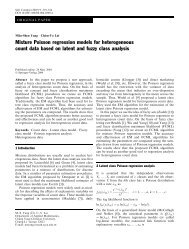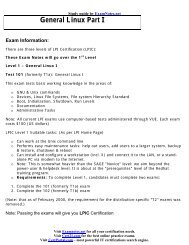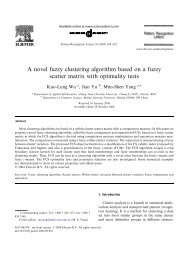A control chart pattern recognition system using a statistical ...
A control chart pattern recognition system using a statistical ...
A control chart pattern recognition system using a statistical ...
You also want an ePaper? Increase the reach of your titles
YUMPU automatically turns print PDFs into web optimized ePapers that Google loves.
214<br />
J.-H. Yang, M.-S. Yang / Computers & Industrial Engineering 48 (2005) 205–221<br />
Fig. 7. Diagram of the correlation coefficient <strong>recognition</strong> <strong>system</strong>.<br />
On the other hand, unnatural <strong>pattern</strong>s, such as upward (downward) shift and upward (downward)<br />
trend, etc. may incur out-of-<strong>control</strong> signals during the <strong>pattern</strong> length nZ30. We can see this<br />
phenomenon from the ARL values shown in Table 1 of Section 1. The ARL values will drop down from<br />
370 to 6 when the mean m increases from 0 to 2. We know that the smaller ARL exhibits out-of-<strong>control</strong><br />
signal more often, and Fig. 6 is created with x(t)Zn(t)Cdt of Eq. (5) where d is selected from 0.05 to<br />
0.12. According to ARL shown in Table 1, it is quite possible for Shewhart <strong>control</strong> <strong>chart</strong> to have out-of<strong>control</strong><br />
signals for upward shift and trend <strong>pattern</strong>s. These out-of-<strong>control</strong> signals are actually occurred at<br />
nZ46, 48 and 49 in Fig. 6. In fact, some out-of-<strong>control</strong> signals will be also occurred in Fig. 8. Of course,<br />
if an out-of-<strong>control</strong> signal is issued in Shewhart <strong>control</strong> <strong>chart</strong>, we stop the process and check the causes<br />
and then remove them. If an unnatural cause can be detected and removed, such as upward shift or trend,<br />
the model will become x(t)Zn(t), i.e. a normal <strong>pattern</strong>. However, it may be difficult for detecting such<br />
unnatural <strong>pattern</strong>s <strong>using</strong> the Shewhart <strong>control</strong> <strong>chart</strong> because ARL will decrease when a mean m increases.<br />
This is the point that a <strong>control</strong> <strong>chart</strong> <strong>pattern</strong> recogniser is useful for recognizing unnatural <strong>pattern</strong>s in<br />
<strong>control</strong> <strong>chart</strong>s. Thus, the main idea of the proposed correlation coefficient method is that, if we do not<br />
have enough evidence to classify an input <strong>pattern</strong> as an unnatural <strong>pattern</strong>, even though it has a maximum<br />
correlation coefficient value to reference <strong>pattern</strong>s, we still wait and take it as a normal <strong>pattern</strong>. The<br />
diagram of our <strong>recognition</strong> <strong>system</strong> is shown in Fig. 7.<br />
Because the <strong>statistical</strong> correlation coefficient r has a constraint with the range in the closed interval<br />
[K1,1], the threshold h can be used as a criterion what the similarity degree is enough for the <strong>recognition</strong><br />
of an unnatural <strong>pattern</strong>. The <strong>pattern</strong> length for generating an unnatural <strong>control</strong> <strong>chart</strong> <strong>pattern</strong> and sample<br />
numbers in our simulations are chosen with nZ30 and NZ200. The moving window for the <strong>recognition</strong><br />
of <strong>control</strong> <strong>chart</strong>s uses a window size 30. For the normal <strong>control</strong> <strong>chart</strong> <strong>pattern</strong>, we take the sample number<br />
with NZ1000. Based on a threshold h, unless there exists sufficiently unnatural <strong>pattern</strong> evidence,<br />
we regard it as a normal and wait for more <strong>pattern</strong> information. According to the recommendation in<br />
Section 2, we choose hZ0.5 in our simulations. We implement 1000 runs for each <strong>pattern</strong> and then<br />
calculate its average accuracy as shown in Table 2.<br />
We mention that these testing samples are also simulated <strong>using</strong> the inner-product technique proposed<br />
by Al-Ghanim and Ludeman (1997). There are almost the same average accuracy as our approach when<br />
hZ0.4 in Table 2 for recognizing upward trend, downward trend, cyclic and <strong>system</strong>atic <strong>pattern</strong>s.<br />
However, if we add upward shift and downward shift <strong>pattern</strong>s, then their <strong>recognition</strong> average accuracy







